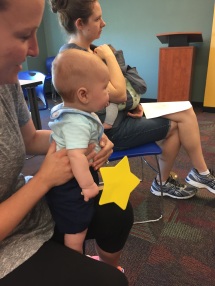Here are the levels of play in children:
Solitary Play: Playing alone
Onlooker Play: the child observes other children in play
Parallel Play: the child plays beside another, playing with the same materials, but not together
Associative Play: the child plays together with several children in a disorganized manner
Cooperative Play: the child accepts a role in play with others, but depends on the others to achieve his goals in play
I encourage you to move with the child from where she is functioning now, rather than trying to pull her up to a level of functioning expected for her age level. She will make more progress this way and you will enjoy the journey!!
The play strategy I am suggesting that should be used in every Early Childhood classroom for children with disabilities and by parents at home is the following:
Imitative Match Play
–When you are playing with your child, provide several different like pairs of toys, if possible. If you are a parent, just find these objects in your kitchen—2 measuring cups, two spoons and two bowls, etc. Initially, just get down on your child’s level, so you are not towering over her, and observe her playing with the objects, noting what she is doing with the toys.
–Next, copy what she is doing exactly (put the toy up to your mouth, bang it , tap something else with it, etc.). Do whatever she does with the like object in the same way that she does, and make the same sounds (you will feel silly, but that is o.k.). Be sure you are on her level on the floor while playing beside her and that you look at her face, frequently. Do this as long as she is with you. If she turns away, simply follow her and copy her actions with the next object in the same way.
–If The child’s eye contact is fleeting, whenever she does look quickly at you, say “There you are!”. You are wanting her to eventually notice you doing the same thing she is doing with the object like hers, and for her to note that you are imitating her noises, sounds, words, as well and enjoying the interaction with her. You are letting her know you are accepting her on her level and are willing to move with her in her world.
–When your child shows she is aware of your actions, go back and forth with her, imitating her sounds and playing with the toys or other objects in her environment (Ex. she taps the spoon on her mouth-you tap the spoon on your mouth-she taps the spoon on her mouth-you tap the spoon on your mouth, etc.). After you have gone back and forth with her like this several times, she is ready for you to change your movement and extend her play with the object (Ex: you tap your spoon in the bowl-stop and wait to see if she copies you). If she does copy you, continue to follow her actions. It may take several times of playing with matching, before she will follow your new action. That is o.k. I find kiddos eventually start going back and forth in turn-taking with you after you play beside them and copy their actions for several minutes. Depending on the child’s abilities, this matching may take several play times over a period of time.
–Once your child copies your actions in turn-taking, she is ready for you to extend her play further by doing something like stirring your spoon in the bowl. Be patient and eventually she will get to the point that she is wanting you to copy her, play beside her, interact with her, etc.
In summary, during play with familiar objects, you copy her actions with the object until you get into a back and forth turn-taking with her; then, extend her play by doing something a little different and see if she will match you.
This technique is so effective in building your relationship with her during play, in order for you to move her forward in developing her abilities and variety of play schemes. I am more than happy to answer your questions, or help you in any way that I can! Have fun!
Terry Grosvenor
Sent from my iPad



